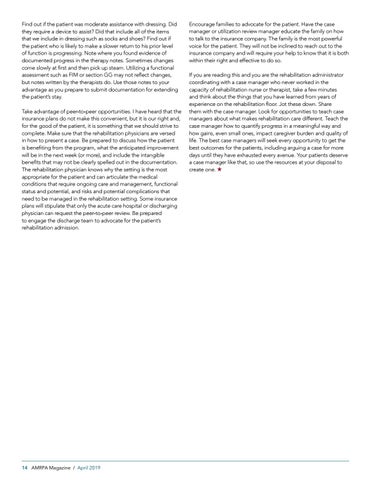Find out if the patient was moderate assistance with dressing. Did they require a device to assist? Did that include all of the items that we include in dressing such as socks and shoes? Find out if the patient who is likely to make a slower return to his prior level of function is progressing. Note where you found evidence of documented progress in the therapy notes. Sometimes changes come slowly at first and then pick up steam. Utilizing a functional assessment such as FIM or section GG may not reflect changes, but notes written by the therapists do. Use those notes to your advantage as you prepare to submit documentation for extending the patient’s stay. Take advantage of peer-to-peer opportunities. I have heard that the insurance plans do not make this convenient, but it is our right and, for the good of the patient, it is something that we should strive to complete. Make sure that the rehabilitation physicians are versed in how to present a case. Be prepared to discuss how the patient is benefiting from the program, what the anticipated improvement will be in the next week (or more), and include the intangible benefits that may not be clearly spelled out in the documentation. The rehabilitation physician knows why the setting is the most appropriate for the patient and can articulate the medical conditions that require ongoing care and management, functional status and potential, and risks and potential complications that need to be managed in the rehabilitation setting. Some insurance plans will stipulate that only the acute care hospital or discharging physician can request the peer-to-peer review. Be prepared to engage the discharge team to advocate for the patient’s rehabilitation admission.
14 AMRPA Magazine / April 2019
Encourage families to advocate for the patient. Have the case manager or utilization review manager educate the family on how to talk to the insurance company. The family is the most powerful voice for the patient. They will not be inclined to reach out to the insurance company and will require your help to know that it is both within their right and effective to do so. If you are reading this and you are the rehabilitation administrator coordinating with a case manager who never worked in the capacity of rehabilitation nurse or therapist, take a few minutes and think about the things that you have learned from years of experience on the rehabilitation floor. Jot these down. Share them with the case manager. Look for opportunities to teach case managers about what makes rehabilitation care different. Teach the case manager how to quantify progress in a meaningful way and how gains, even small ones, impact caregiver burden and quality of life. The best case managers will seek every opportunity to get the best outcomes for the patients, including arguing a case for more days until they have exhausted every avenue. Your patients deserve a case manager like that, so use the resources at your disposal to create one.
